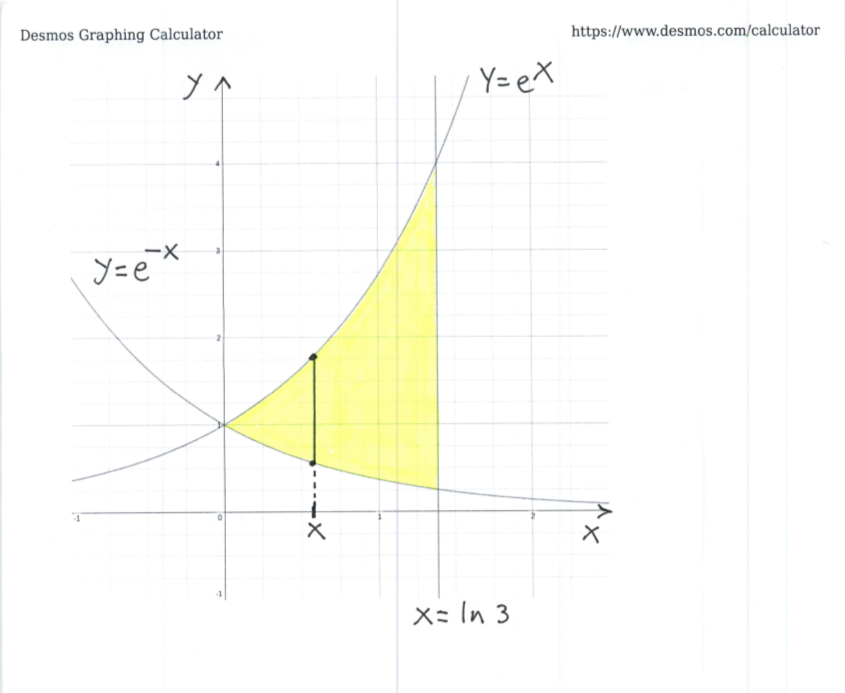SOLUTION 3: Compute the area of the
region enclosed by the graphs of the equations $ y=e^x $, $
y=e^{-x} $, and $ x=\ln 3 $ . Begin by finding the points of
intersection of the two graphs. From $ y=e^{x} $ and $ y=e^{-x} $
we get that
$$ e^{x} = e^{-x} \ \ \longrightarrow $$
$$ e^{x} = 1/e^{x} \ \ \longrightarrow $$
$$ e^{2x} = 1 \ \ \longrightarrow $$
$$ 2x = 0 $$
$$ x = 0 $$
From $ y=e^{x} $ and $ x= \ln 3 $
we get that (Recall that $ e^{\ln A}=A $.)
$$ y=e^{\ln 3} \ \ \longrightarrow \ \ y=3 $$
From $ y=e^{-x} $ and $ x= \ln 3 $
we get that (Recall that $ B \ln A= \ln A^B $.)
$$ y=e^{-\ln 3} = e^{\ln 3^{-1}} \ \ \longrightarrow \ \ y=3^{-1}= \frac{1}{3} $$
Now see the given graph of the enclosed region.

Using vertical cross-sections to describe this region, we get that
$$ 0 \le x \le \ln 3 \ \ and \ \ e^{-x} \le y \le e^{x} , $$
so that the area of this region is
$$ AREA = \displaystyle{ \int_{0}^{\ln 3} (Top \ - \ Bottom) \ dx
} $$
$$ = \displaystyle { \int_{0}^{\ln 3} (e^{x} - e^{-x}) \ dx } $$
$$ = \displaystyle { \Big(e^{x} - (-e^{-x})\Big) \Big\vert_{0}^{\ln
3} } $$
$$ = \displaystyle { \Big(e^{x} + e^{-x}\Big) \Big\vert_{0}^{\ln 3}
} $$
$$ = \displaystyle { \Big(e^{\ln 3} + e^{-\ln 3}\Big) - \Big(e^{0}
+ e^{-0}\Big) } $$
$$ = \displaystyle { \Big(e^{\ln 3} + e^{\ln 3^{-1}}\Big) - \Big(1
+ 1 \Big) } $$
$$ = \displaystyle { \Big(3 + \frac{1}{3}\Big) - 2 } $$
$$ = \displaystyle { \Big(\frac{10}{3}\Big) - 2 } $$
$$ = \displaystyle { \frac{10}{3} - \frac{6}{3} } $$
$$ = \displaystyle { \frac{4}{3} } $$
Click HERE to return to the list of problems.

